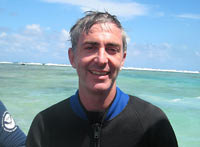|
You
are here: /main/research
expeditions/August/September 2007/Sean Corson
Interview
with Sean Corson, Chief Scientist
by Carlie Wiener
Click
here to see where the Hi'ialakai is now.
Click
here to see current data from the ship
 Biography Biography
Mr. Corson became interested in environmental management
early on; he was always attracted to marine science as
a kid and recalls fishing and tide pooling at a young age.
He studied bottom fisheries in his earlier research before
working with the Monument. He began teaching environmental
education on boats right after college in California’s
Channel Islands. It was through that position that he became
familiar with the NOAA Sanctuaries Program. Mr. Corson
has been with the Monument for many years, and came out
to Hawaii for the purpose of working with the Northwestern
Hawaiian Islands. He started working with the area when
it was a reserve, through the sanctuary process, until
present day Monument designation. This is Mr. Corson’s
fourth time visiting the Monument.
Role on the research trip
Mr. Corson will be working to assist the Maritime
Heritage Group with Dr. Hans Van Tilburg, Dr. Kelly Gleason
and Tane Casserly. He is really excited about working in
this area as he has always had a fascination with older
boats, and comes from a family that worked building wooden
boats. Mr. Corson is also acting as the chief scientist
on this expedition, which is a critical role to the trip.
He is coordinating the research activities on the boat,
and working with the principal investigators to ensure
the research and general ship life run smoothly. Mr. Corson
also has the difficult job of determining the locations
of the daily research excursions, working with the scientists
to ensure everyone meets their research goals in a safe
manner.
What he hopes to find
Mr. Corson is interested in capitalizing on the
opportunity to work with the co-trustees and other research
partners to develop best management practices. He articulates
that there have been groups working closely together for
a long time at the Monument. “Over twenty years of
work and shared field research have been conducted collectively. However,
the Monument designation has brought this work together
as a formal connection, improving cooperation to help preserve
this special place”.
What do you find challenging about your role
Mr. Corson has been very pleased with the way the research
expedition has run so far. He is impressed with how easy
the crew has made the trip. He states that “the congeniality
of the group is outstanding; people are here to help one
another”. Mr. Corson found the most difficult part
was to get the trip up and running, ensuring both the crew
and scientists got what they needed to achieve their goals.
How the science helps to inform Management
Mr. Corson is enthused by the possibilities of the research
currently occurring at the Monument. Using science to inform
management is one of the underpinnings of the work, with
the research geared towards this goal. This has huge implications
for management purposes creating a close community of both
scientists and managers. As a manger, Mr. Corson feels
that this type of science has tremendous applications to
really understanding ecosystem management. Important concepts
such as connectivity are essential to understanding potential
stressors and preventative measures for the marine environment.
There is often a huge lag in time between science and policy
but with the Monument, firsthand experience is leading
directly to its management.
Favorite part about being at sea
The constant ocean surroundings and observing the
changes in the water is Mr. Corson’s favorite part
of being out at sea. He enjoys observing the change in
wave and swell direction, and is impressed by the surreal
experience of the wilderness. He also enjoys learning from
both the scientists and ship crew and being exposed to
a wide variety of interesting people.
Click
here for maps of the region
|